A cylinder is an actuation device that uses the energy from pressurized hydraulic fluid to move itself in linear. A cylinder can exert extremely high force during its linear motion. It’s the main reason why engineers draft the hydraulics and pneumatics systems so carefully. Many modern applications are simply impossible or impractical without using cylinders. Driven by industrial needs, cylinders have grown into a vast array of different special designs, sizes, and configurations. The branching of cylinder types variations allows continuous innovative designs.
Table of Contents
Double acting hydraulic cylinder is the most common cylinder configuration. The main features of a double-acting cylinder includes a piston, piston rod, rod-end port, cap-end port, and the barrel. By sending pressurized fluid to the rod-end port, the piston rod will retract and by sending pressurized fluid to the cap-end port the piston rod will extend. At the same time, the fluid on both end of the piston is sent back to the fluid reservoir. When air is used, it is normally routed to the vents and into the atmosphere. If we use equal pressure of the fluid on both ends, then the retraction force will be smaller than the extension force because the area of the cap-end piston is greater than the rod-end piston. When the cylinder is fully retracted, the rod volume will decrease the total cylinder volume. And by assuming equal fluid flow rate, the cylinder will extend slower than it retracts. That’s the gist of how this type of cylinder works.
The variations in construction of double-acting cylinders are mainly based on the way the end caps are attached to the barrel. More variations include materials used and wall thickness between the end caps and the barrel. The constructions you will commonly see are the tie-rod cylinders, welded cylinders, mill-duty cylinders, and non-repairable cylinders. Common variations of these constructions include single-rod end, double-rod end, telescoping, ram, short-stroke, tandem, duplex, and diaphragm cylinders.
Despite the many variations in construction, the most common type of double-acting cylinders you’ll see in heavy machineries are the single-rod end tie-rod and welded cylinders. These two can be easily found in loaders, tractors, grapples, and even home-made machineries. As the name implies, tie-rods cylinder uses multiple rods installed on the exterior of the cylinder, extending from one cap to the other. These rods are there to withstand most of the pressure load when the cylinder is operational. On welded cylinders, both end caps are welded to close the cylinder barrel tightly. Generally, these cylinders are narrower and shorter compared to tie-rod cylinders. This makes them ideal to be used in machines where space is a limiting factor. The absence of tie-rods enables them to have a larger bore size despite having the same dimension as their tie-rod counterpart.
Some consider welded cylinders superior to tie-rod cylinders. Welded cylinders are less prone to stretching under heavy load and long strokes. They also don’t need as many regular maintenances compared to tie-rod cylinders. This does not mean tie-rod cylinders has no advantage whatsoever compared to welded cylinders. When we’re talking about cost, then tie-rod cylinders win hands down, especially in agricultural industry.
Just like any other mechanical components, the cylinders may break and need replacement. In many cases, it is not necessary to replace a broken cylinder with its OEM replacement. You only need to find a replacement with the same specs as the broken one. Some specs you need to pay attention to are bore size, work pressure, rod size, mount type, type of cylinder, and stroke. Often times this will save you a large amount of money and also time. OEM parts are not always in stock. When you’re on a tight schedule and it’s not feasible to wait for two weeks for an OEM cylinder to arrive then buying an aftermarket cylinder from a reputable brand is the better choice.
With so many hydraulic cylinders in the market, it’s going to be hard finding the one that best suit your requirements. This article is aimed at making your decision easier. We have reviewed four excellent double acting cylinders that really can take heavy load day after day.
Remember, if you are unsure of the specs of the cylinder that you need to buy, it’s best to consult the user manual that comes with your machine. It will save a lot of hassle of returning the wrong cylinder and it will obviously save your precious time.
Double Acting Hydraulic Cylinder Reviews
Mighty Double Acting Hydraulic Welded Cylinder
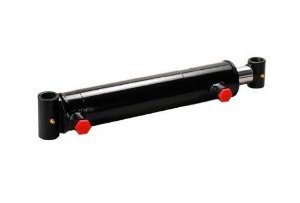 This is a standard hydraulic cylinder that will work with many heavy machineries in civil engineering, manufacturing, agricultural industries, waste, transportation, and construction. It features weld-on cross with all-steel welded construction. It’s rated at 3,000 PSI operating pressure. The heavy wall steel tubing ensures this cylinder can withstand great force and thus appropriate for heavy-duty use. The piston rod is made from medium tensile carbon steel, ground and polished with hard chrome plating to assure smooth movement with minimal friction against the steel barrel and high resistance to rust.
This is a standard hydraulic cylinder that will work with many heavy machineries in civil engineering, manufacturing, agricultural industries, waste, transportation, and construction. It features weld-on cross with all-steel welded construction. It’s rated at 3,000 PSI operating pressure. The heavy wall steel tubing ensures this cylinder can withstand great force and thus appropriate for heavy-duty use. The piston rod is made from medium tensile carbon steel, ground and polished with hard chrome plating to assure smooth movement with minimal friction against the steel barrel and high resistance to rust.
The piston is made of cast iron manufactured to high standard and ideal for high-pressure environment. It also has back up washers and O-rings for a proper seal. All seals are manufactured to conform to US specifications. Built-in trac-type gland retainer is made to withstand high pressure.
Manufactured by Mighty Hydraulics, this double-acting cylinder only weighs 37 pounds and offers excellent performance. All cylinders made by Mighty Hydraulics must complete 100% hydro-pressure tests to make there are no leaks, and the cylinders are strong enough to withstand the operating pressure. The piston pin diameter is 1-inch with 1.5-inch shaft. When fully retracted the cylinder length is measured at 32-inch and 56-inch when fully extended. This double-acting cylinder uses SAE 8 work port. The number 8 refers to the recommended size of tubing for the port which is 0.5 inch.
To ensure high performance and long life expectancy of the cylinder make sure you read the warning labels and instructions. Inspect each component before setting up the system. Do not use the cylinder if there are worn out or damaged parts. Be sure to fill the oil pump strictly when the cylinder is fully retracted and fill it to the recommended level. Stick to the recommended oil viscosity grade to ensure a dependable cylinder operation.
Prince B350240ABACA07B Double-Acting Tie-Rod Hydraulic Cylinder
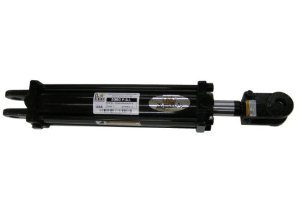 This is a tie-rod hydraulic cylinder made by Prince Manufacturing Corporation. Prince Manufacturing Corporation was established in 1941. Located in Sioux City, Iowa, this company was originally known as Prince Hydraulics. Current product line includes hydraulic control valves, hydraulic cylinders, and gear pumps.
This is a tie-rod hydraulic cylinder made by Prince Manufacturing Corporation. Prince Manufacturing Corporation was established in 1941. Located in Sioux City, Iowa, this company was originally known as Prince Hydraulics. Current product line includes hydraulic control valves, hydraulic cylinders, and gear pumps.
This double-acting cylinder has 3,000 PSI max operating pressure. The tie rod is made from high strength steel able to withstand huge loads. What set apart Prince’s cylinders to their competitors is the Royal Plate Plus coating on the cylinder rods. It combines hard chrome as the top coating and nickel as the undercoating. It offers superior protection against corrosion and excellent wear resistance. Cylinder rods treated using Royal Plate Plus resist corrosion and rust better than the ones treated using hard chrome plus gas nitride. This is why the rods treated with Royal Plate Plus come with 7 years of rust and corrosion warranty.
The piston, gland, clevis, and butt are made of ductile iron for durability and strength while the end fittings are made from cast steel offering both high strength and low cost. All the seals are made from urethane and locally sourced in North America for dependability. Top port design allows easy access to pneumatic connections plus thread-in gland for easy maintenance and serviceability. The ports are SAE (Society of Automotive Engineers) size 8 with O-rings for leak-free and reliable connection. Both ends have clevis mounts with 1-inch pin diameter and UNF (Unified Fine Thread) threading. The exterior of the cylinder is painted in high luster black paint to protect it from harsh elements. It’s ideal to be used on farm machinery and other locations where dirt, mud, and rough weather can pose a problem. Prince cylinders have been thoroughly tested to assure high quality and performance. Each of Prince manufactured cylinders is bagged and boxed individually to assure secure storage and transport.
Prince Tie-Rod Cylinder
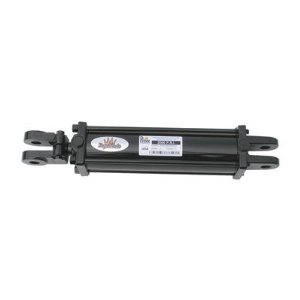 Prince tie-rod cylinder offers amazing performance and value. This hydraulic cylinder is rated at 3000 PSI and offers plenty of tolerance up to 5000 PSI burst. It has 24-inch stroke and 5-inch bore with 54510 lbs maximum column load. Honed Tubing improves smooth piston movement throughout the cylinders. The tube wall is 0.25-inch thick with clevis mounts at the base and the rods. The rod clevis comes with 1.25-inch pins and the base clevis has 1.375-inch pins. The minimum distance between the ears is 1.13-inch at the center line.
Prince tie-rod cylinder offers amazing performance and value. This hydraulic cylinder is rated at 3000 PSI and offers plenty of tolerance up to 5000 PSI burst. It has 24-inch stroke and 5-inch bore with 54510 lbs maximum column load. Honed Tubing improves smooth piston movement throughout the cylinders. The tube wall is 0.25-inch thick with clevis mounts at the base and the rods. The rod clevis comes with 1.25-inch pins and the base clevis has 1.375-inch pins. The minimum distance between the ears is 1.13-inch at the center line.
This cylinder uses high strength, heavy duty tie rods. The piston rods are induction hardened to improve durability and resistance to wear. This treatment is important for components that are subjected to heavy impact forces and loading. Induction hardening is the becoming the choice of hardening for cylinder manufacturing because it is very quick and efficient. It allows localized hardening where the core of the steel remains the same. This process also has high-quality control. The piston rods will have less hardness distortion compared to other heating methods like flame hardening or carburizing. At the end of the day, the increase in durability and wear resistance ensure the cylinder will remain at its top performance for many years to come.
Just like any other Prince cylinders, the rod is also treated with Royal Plate Plus for excellent corrosion and wear resistance. It has 7 year warranty on rods. The exterior is painted aircraft-grade 2-part chemical cure polyester urethane paint. It will not fade and many times better than powder coating. It will protect the cylinder from the elements in
This tie-rod cylinder is the economically sound solution for when you need a replacement cylinder on your loader or tractor. If you want a high-quality double acting hydraulic cylinder without the exorbitant price tag, this will do really well.
G-FORCE 11436 3-Inch Bore 24-Inch Stroke Tie Rod Hydraulic Cylinder
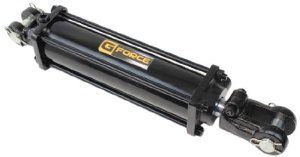 This tie-rod cylinder is a good choice for stump grinder, snow blower, tractor, and other machines that require a 3-inch bore, 24-inch stroke cylinder. It has clevis mounts, 1.125 inches between the ears, with pins and clips included. The rated working pressure is 2500 PSI with a maximum pressure of 3850 PSI. With such a high-pressure tolerance this cylinder is not prone to wear due to pressure burst.
This tie-rod cylinder is a good choice for stump grinder, snow blower, tractor, and other machines that require a 3-inch bore, 24-inch stroke cylinder. It has clevis mounts, 1.125 inches between the ears, with pins and clips included. The rated working pressure is 2500 PSI with a maximum pressure of 3850 PSI. With such a high-pressure tolerance this cylinder is not prone to wear due to pressure burst.
The shaft diameter of this cylinder is 1.25 inches and the barrel thickness is 0.189 inches. The cylinder is measured at 58.25 inches when fully extended and 34.25 inches when retracted. It uses 0.5-inch NPTF ports and weighs 40.9 pounds. All of the seals used in this cylinder are made to comply with US specification. It has the standard chrome-plated rod and has passed 100% hydro-pressure test to ensure quality and zero leakage.
Nothing about this cylinder makes it stand out among its competitors. It does not have Royal Plate Plus treatment like the cylinders made by Prince Hydraulics nor high tensile steel piston from Magister Hydraulics. The paint is not aircraft-grade, and it only has a 1-year limited warranty. It’s certainly a no match for However, even though it’s considered a generic cylinder it does not mean it’s a bad choice.
Should you buy this double acting cylinder?
That greatly depends on what you want and what you need in your line of work. If the cylinder on your tractor is busted and this one happens to have the all the right specs, then it will make a good candidate replacement regardless the lack of distinguishable features. As mentioned earlier, if getting OEM replacement parts is not feasible then buying an aftermarket part is the solution. This cylinder does use standard ports and port thread so compatibility should not be an issue here.
Double Acting Welded Hydraulic Cylinder
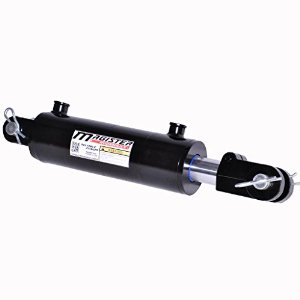 This is a double-acting welded hydraulic cylinder with clevis end, and it has more to offer regarding strength and customization compared to the tie-rod cylinder. This type of cylinder fit better in mobile equipment applications since it is lighter and more compact. It also requires less maintenance compared to the tie-rod cylinder. With 3-inch bore, 16-inch stroke, and operating pressure range rated at 3000 PSI it’s an excellent cylinder for heavy duty applications.
This is a double-acting welded hydraulic cylinder with clevis end, and it has more to offer regarding strength and customization compared to the tie-rod cylinder. This type of cylinder fit better in mobile equipment applications since it is lighter and more compact. It also requires less maintenance compared to the tie-rod cylinder. With 3-inch bore, 16-inch stroke, and operating pressure range rated at 3000 PSI it’s an excellent cylinder for heavy duty applications.
The piston is made of high tensile steel instead of ductile iron. It uses top quality U-cup polyurethane seals with inner O-ring to reduce friction inside the chamber and extend the cylinder’s lifespan. This combination makes the cylinders have more durable characteristics compared to any regular cylinders using ductile iron pistons. The average lifespan for this combination is 7 years. Much higher than cylinders using ductile iron piston which only about 3 years. The base ends and clevis are made from durable forged iron. One inch pins are included along with the clips. Both ports use standard SAE 8 O-rings for improved compatibility.
Everything in this cylinder is made to be reliable in extreme weather conditions, from the tropics to tundra. The cylinder has gone through 150% max pressure test before being shipped.
This hydraulic cylinder is made by Magister Hydraulics, a European company currently expanding its market in North America. Their hydraulic device components have been proven to be reliable. All the main components are made in-house from high-quality materials supplied by industry leading suppliers. Magister produces hydraulic cylinders in various piston sizes, up to 9-inches diameter pistons. Even though their manufacturing facilities are positioned in Ukraine, all the products sold in North America comply with US standards and have one year warranty. The manufacturing process complies with an ISO9001 standard that focuses continuous quality control management.
Conclusion
Aftermarket double acting hydraulic cylinder makes a viable alternative compared to OEM cylinder. It offers more value, since it is more readily available in the market, you won’t need to compromise your tight schedule. You just need to get the one with the correct type, bore size, stroke, mounting, and working pressure and you’re all set. Standards are made for a reason, and the double acting cylinders reviewed above are good examples of high-quality cylinders made to conform with US standards.

